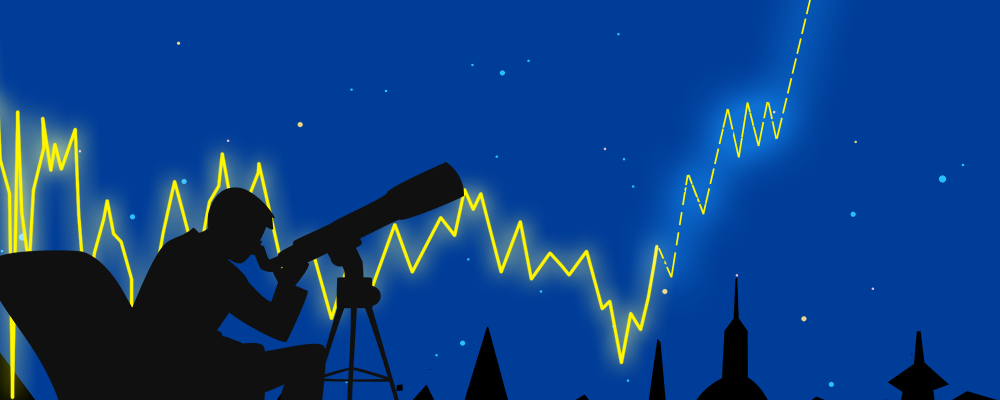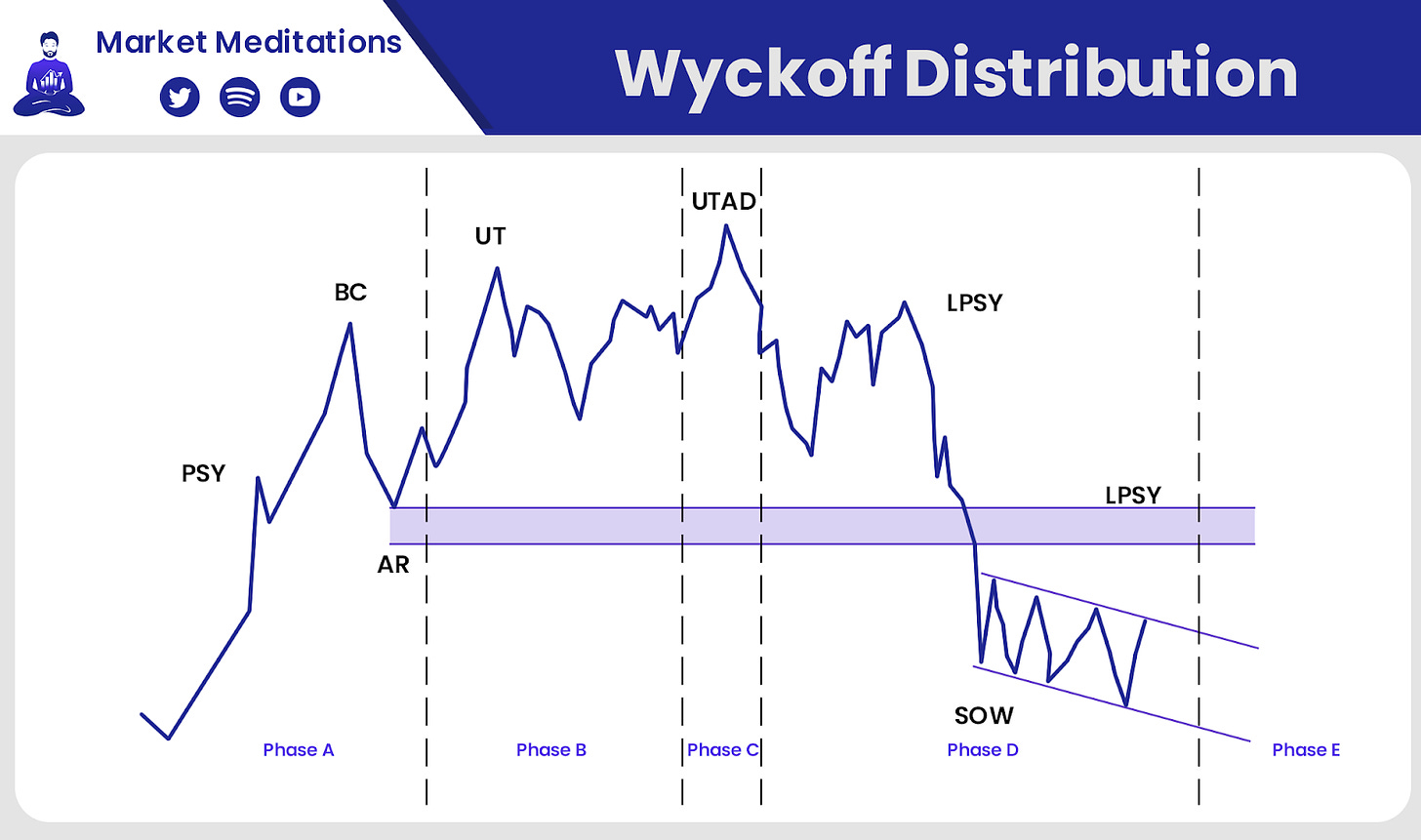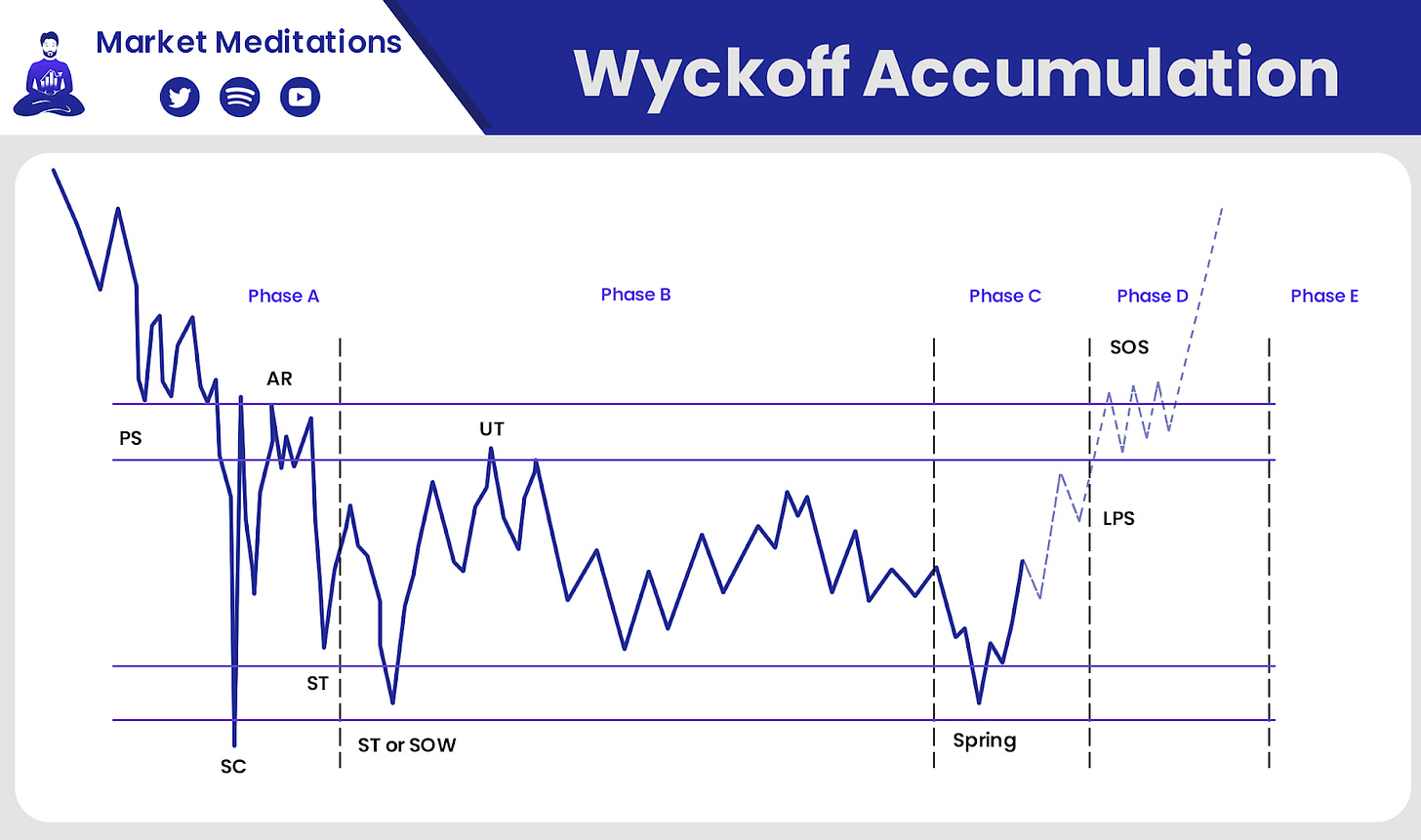Wyckoff Method Guide – Part 2
Market Meditations | June 10, 2021

✨ Written In The Wyckoff Stars
In Part 1 of this guide, we discussed the theory behind the Wyckoff Method. If you haven’t yet read Part 1, make sure to do so before continuing as this will give you an overview of the theory behind Wyckoff.
In summary, the Wyckoff Method posits that there is an imaginary identity known as the Composite Man who represents the biggest players in the market. The Composite Man acts in his best interest to ensure he can buy low and sell high by using a somewhat predictable strategy. In this regard, Wyckoff’s accumulation and distribution schematics help us better understand the psychology behind the big players in the market and assign probabilities to what will happen next.
So why are we covering Wyckoff now, you might ask? It could be argued, for those who employ the Wyckoff Method, that Bitcoin price action is printing a HTF Wyckoff Distribution schematic. There is also a case, however, for a Wyckoff Accumulation schematic. In this article, we will present the case for both and offer our conclusion thereafter.
? Bitcoin Distribution Scenario
Shown above is the current Bitcoin price action on the 1D chart split and labeled into five phases as per the Wyckoff distribution schematic. Let’s take a look at each phase and the components therein to dissect the psychology of big money and retail traders and understand how Wyckoff may try to explain recent market conditions.
- Phase A. We know that Bitcoin price action was in a massive uptrend with little to no consolidation after the break of the 2017 ATH at $20,000. Price continued climbing to the 50,000 psychological level at which it could be argued that Preliminary Supply (PSY) proved that selling force is present, but not enough to catalyse a downward reversal. At this point, we saw the Buying Climax (BC) wherein Bitcoin rallied from $50,000 to $58,000: “Bitcoin is going to 100k!” “If you’re not buying Bitcoin, you’re NGMI” “I just took out a loan to buy Bitcoin” Wyckoff would argue that the rally from $50,000 was fueled by retail traders who make the aforementioned statements and trade emotionally. This excessive demand is then absorbed by big players who took advantage of the euphoria to offload big positions in Automatic Reaction (AR), sending the price back down to $45,000 before an arguably shallow Secondary Test (SB) at the $50,000 level to create a lower high.
- Phase B. Next we entered a consolidation phase wherein price bounced between $61,000 and $50,000 to allow the Composite Man to gradually sell his assets into liquidity from retail traders longing every bounce in the hope that the market would return to “easy mode.” If you remember, this period was filled with several bear and bull traps designed to frustrate retail traders. Indeed, the market moved above the Buying Climax (BC) of $58,000 leading to the Upthrust (UT) at $61,000, trapping everyone playing the breakout play and allowing big money to offload coins.
- Phase C. Indeed after a period of consolidation between $61,000 and $50,000, the Composite Man appeared to print one last bull trap by pushing price from $61,000 to $65,000 level known as the Upthrust After Distribution (UTAD). Psychologically, this again traps retail traders playing the ATH breakout and allows big money to offload a large quantity of coins. The demand from retail traders gives big players enough liquidity to sell continuously without causing a big spike down in the market.
- Phase D. Notice how following the Upthrust after Distribution (UTAD), the price tumbled underneath the Upthrust (UT) at $61,000 down to $47,500, before it rallied back up to $57,000 to test the Last Point of Supply (LPSY). It then fell aggressively below the Accumulation Range (AR) during the massive Bitcoin sell-off down to $30,000. Here is where things get interesting. According to the schematic, before the price moves to the Sign of Weakness (SOW) part of Phase D, it must head back up to test the bottom of the Accumulation Range (AR) at $43,000 as the Last Point of Supply (LPSY). Why is this important? When the price rejects at the Last Point of Supply (LPSY), it suggests buyers are no longer interested. This psychology is what ultimately leads to the Sign of Weakness (SOW) where price prints lower highs and lower lows before ultimately heading into Phase E. Currently, price is consolidating below the base of the Accumulation Range (AR). What happens next could be the determining factor of whether the bull market continues or a bear market begins.
If price is able to break up from consolidation and reclaim the $45,000, this would suggest that $45,00 was not, in fact, the Last Point of Supply (LPSY) and buyers were willing to defend the level. Technically, this would invalidate the distribution schematic, which could suggest further upside. If, however, price breaks down from this consolidation or breaks up, retests the $45,000 level as resistance, and rejects, a new downtrend could form.
? Bitcoin Accumulation Scenario
Now let’s take a look at another perspective also referencing Wyckoff. This time, we’ll see Bitcoin price action through the lens of Wyckoff’s accumulation schematic on the 4H chart.
- Phase A. Whilst selling force was present from the $61,000 level, buyers showed up at Preliminary Support (PS). Just like Preliminary Supply (PSY), the demand was not enough to stop the downtrend until the Selling Climax (SC) where the Bitcoin price cratered to $30,000, a time of high volatility and panic selling in line with Wyckoff’s theory. We saw a quick bounce back up to $42,000 during the Automatic Rally (AR) followed by a Secondary Test (ST) where the market printed a higher low at $31,000 before moving back up.
- Phase B. The higher low at $31,000 has been followed by long consolidation, the “Cause” (consolidation) that theoretically leads to an “Effect.” (expansion). In other words, the Composite Man uses this phase to accumulate as much Bitcoin as he possibly can, anticipating an upward trend shortly thereafter. In line with the model, Bitcoin has tested both resistance and support several times without confidently breaking to either side. You’ll notice upon close look, especially on the lower time frames, that the market has printed several bull and bear traps, frustrating breakout longs and shorts consistently.
- Phase C. It could be argued that just yesterday the market moved into Phase C, printing its final bear trap before expansion upward. Indeed we saw an aggressive sell off down to $31,000 before the market bounced back up quickly. Wyckoff calls this the “Spring,” and according to the schematic is the final bear trap before the market should begin making higher lows, as it has since the sell off. In theory, the Composite Man pushed the price down to $31,000 in a final attempt to accumulate as much Bitcoin as possible. He does so by stopping out traders who are long and fooling traders who open shorts.
- Phase D and E: It remains to see whether Bitcoin price action will continue to follow the accumulation schematic and expand upwards or whether it will invalidate and proceed to make lower lows thereafter. Let’s take a look at both scenarios so that we can profit from either outcome.
If price continues to print higher lows and we see volume increase, there is an argument to be made that we will test the previous Upthrust (UT) at $40,000. It’s likely that sellers will push the market down on the first test of this level, so the true test will be whether the market can print a Last Point of Support (LPS), a final higher low before expansion out of the accumulation range above $42,000. If price can breakout above $42,000, traders who use the Wyckoff schematic would look for a Sign of Strength (SOS) as the previous 42,000 resistance becomes support, before ultimately breaking out of the trading range and starting a new uptrend.
? Conclusion
Regardless of which theories you support, the most important thing is to recognize the role of education, knowledge, and awareness of factors that influence them. Our belief is the Wyckoff Method is but one in a world of technical indicators and should not be used in isolation to make trading decisions. Such indicators enable us to view the market from multiple points of view, enabling us to create a more comprehensive and well-informed trading strategy.
If you enjoy the Wyckoff Method because you value understanding what big players are doing, read our FREE guide on On Chain Analytics which will take this concept one step further. Additionally, make sure to follow us on Twitter for live updates on all catalysts that can affect the price of crypto.



